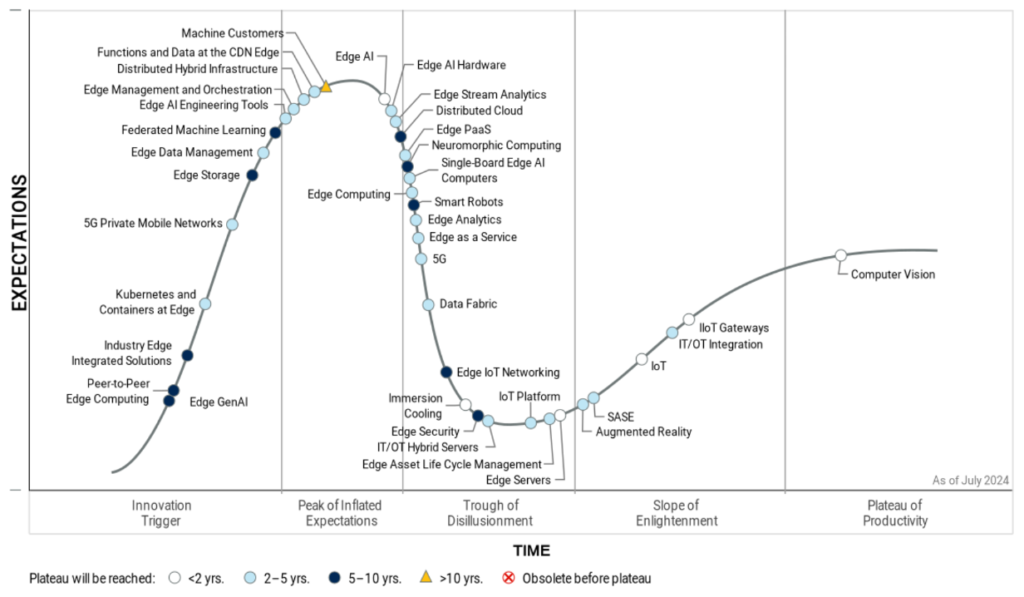The CXOs Guide to Edge Computing
As a CXO, you will inevitably face questions about your company’s strategy for “the edge.” The term can feel like hype, but it reflects a real shift in how companies balance cloud and local IT. Edge is not about abandoning the cloud, it’s about complementing it to meet business needs around responsiveness, resilience, compliance, and cost-efficiency.
According to Gartner’s 2024 Hype Cycle for Edge Computing, the technology is advancing steadily. As reported, the industry is currently positioned between the Trough of Disillusionment and the Slope of Enlightenment. This means:
- Deployments are growing, indicating real-world adoption is underway.
- Supporting technologies are maturing—notably in areas like edge AI and integrated platforms.
- Edge AI is becoming more central in edge strategies, signaling rising practical value.
Edge computing is past the hype and adjustment phase, with real-world deployments unlocking strategic value—particularly in edge AI, integrated solutions, and orchestration tools.

Here are the questions you’re likely to hear and the perspectives you should be ready to offer.
- What is edge computing?
- We run everything in the cloud, why move things on-premise?
- Is edge just on-premise compute like we had before the cloud era?
- Which scenarios and applications are candidates for running at the edge?
- What should I think about when starting to deploy edge?
- How should I think about cost and ROI?
- What about security, I get security from my cloud vendors, is not edge fragile?
- What should I know about selecting an edge platform?
What is edge computing?
Edge computing means running applications and processing data close to where it is generated and consumed — whether that’s on a factory floor, in a retail store, inside a vehicle, or at a branch office. This reduces dependency on remote data centers and improves responsiveness, security, and reliability. Think of it as bringing “cloud-like” agility and automation into your own operational environments.
We run everything in the cloud, why move things on-premise?
Cloud remains essential for scalability, innovation, and global reach. But the cloud alone cannot deliver when applications need real-time response, when sites must keep running during network outages, or when data cannot legally or practically leave the premises. Edge provides the missing link, ensuring local execution of critical workloads while still connecting to the cloud for analytics, coordination, and innovation.
Is edge just on-premise compute like we had before the cloud era?
No. Traditional on-premises IT was static, complex to manage, and lacked flexibility. Modern edge platforms borrow from cloud-native principles: automation, APIs, container orchestration, and lifecycle management at scale. This means you get the speed and agility of the cloud, but applied to distributed sites rather than centralized data centers. Edge is not “back to the old data center”, it’s on-premises reimagined for the cloud era.
Which scenarios and applications are candidates for running at the edge?
Not every workload belongs at the edge. The best candidates are those where latency, reliability, privacy, or bandwidth are decisive factors:
- Real-time automation: robotics, conveyor belt coordination, predictive maintenance.
- Customer experiences: personalized retail, interactive kiosks, low-latency AR/VR.
- Privacy and compliance: healthcare diagnostics, financial transactions, regulated manufacturing data.
- Resilient operations: point-of-sale systems, logistics hubs, transportation fleets, offshore facilities.
A good rule of thumb: if downtime, latency, or compliance violations would hurt your business, that workload is a candidate for the edge.
What should I think about when starting to deploy edge?
Start with the business case. Identify where edge supports resilience, compliance, or new revenue opportunities. Then focus on standardization: a few proof-of-concept deployments might work ad hoc, but scaling to hundreds or thousands of sites requires an orchestration platform that makes deployments, updates, and monitoring uniform. Finally, design with hybrid in mind, edge and cloud should work hand in hand, not in silos.
How should I think about cost and ROI?
Edge computing should be measured against the cost of downtime, the value of compliance, and the revenue impact of better customer experiences. While edge may require initial investment in infrastructure, it pays back by reducing operational disruptions, avoiding regulatory penalties, and enabling innovation that pure cloud cannot.
Unlike the cloud, where OPEX can be unpredictable as usage grows, edge investments are more CAPEX-oriented and predictable, giving you tighter control over long-term costs. ROI is often found in resilience and agility, not just in cutting expenses.
What about security — isn’t edge fragile compared to the cloud?
Security is not automatic, whether in cloud or edge — it’s about design. Edge can actually improve security by limiting exposure: sensitive data stays on-site, reducing the risk of leaks. Modern edge platforms also enforce network segmentation, zero-trust policies, and automated patching across distributed sites. Combined, this means edge does not weaken your security posture, it broadens it, protecting both local systems and the data exchanged with the cloud.
What should I know about selecting an edge platform?
Choosing the right platform is essential. Avoid retrofitting cloud tools or launching internal “DIY” projects, they rarely scale and quickly become security and maintenance burdens.
A purpose-built edge platform should provide:
- Hardware and OS independence
- Networking and segmentation
- Application deployment and orchestration
- Secrets and configuration management
- Monitoring and observability
The right choice keeps the edge manageable at scale and lets you focus on business outcomes rather than stitching infrastructure together.
✅ With this framing, you as a CXO can confidently address questions about edge computing, not in technical terms, but in strategic ones. The key takeaway is that edge is not about replacing the cloud, but about extending your digital capabilities into the physical environments where your business runs.
Key Takeaways for CXOs
- Edge complements, not replaces, the cloud: it brings cloud agility and automation into physical environments where responsiveness, compliance, and resilience matter.
- Not all workloads belong at the edge: focus on those where downtime, latency, or regulatory risk would damage business operations.
- Think in terms of scale and standardization: pilot projects are easy; running edge across hundreds or thousands of sites requires orchestration and automation.
- Edge strengthens your security posture: by keeping sensitive data on-site, enforcing segmentation, and integrating securely with cloud systems.
